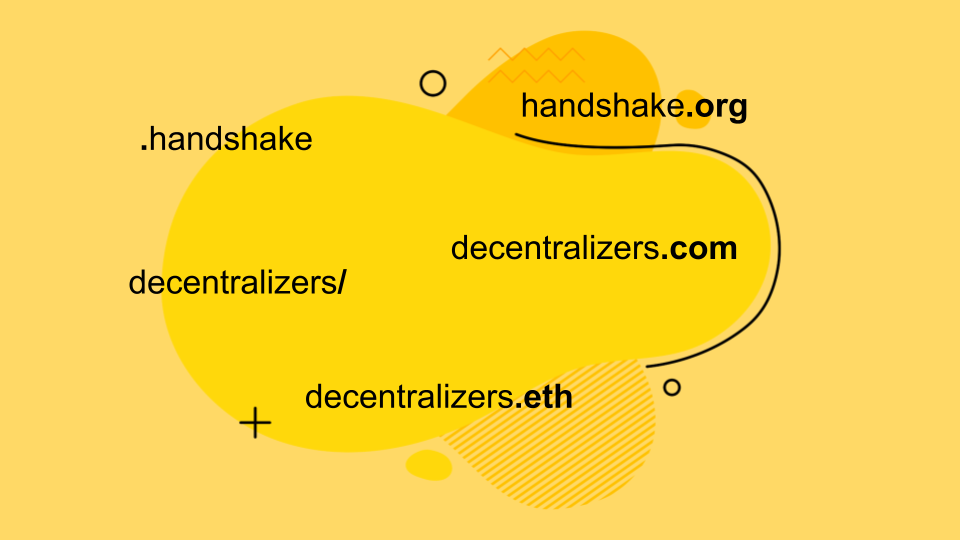8 min to read
Traditional DNS vs. Handshake Protocol: A Security Showdown
Decentralization, Censorship Resistance, and the Future of Domain Name Systems

Detailed Comparison of Traditional DNS Domains vs. Handshake Protocol Domains
Overview of Traditional DNS and Handshake Protocol Domains
Traditional DNS (Domain Name System)
- The traditional DNS is a hierarchical and centralized system that translates human-readable domain names (e.g.,
example.com) into IP addresses (e.g.,192.168.0.1). - It relies on a globally distributed database maintained by authoritative organizations, with the root zone managed by the Internet Assigned Numbers Authority (IANA) under ICANN (Internet Corporation for Assigned Names and Numbers).
- Domain names are bought through accredited registrars and exist within a structured hierarchy (TLDs, like
.com,.org, etc.).
Handshake Protocol (HNS)
- Handshake is a decentralized, blockchain-based alternative to the traditional DNS. It aims to disrupt the centralization of the traditional DNS by eliminating the reliance on centralized entities like ICANN.
- It uses a blockchain-based system to manage the ownership of domain names (top-level domains or TLDs). Instead of registrars, domain ownership is established through auctions on the Handshake blockchain.
- Once a user owns a TLD on the Handshake blockchain, they control that domain completely and are not subject to centralized regulation.
Key Components: Traditional DNS vs Handshake DNS
Traditional DNS
- Root Servers: Managed by ICANN and its partners, the root servers form the foundation of the DNS infrastructure. These 13 root servers [1] are highly centralized.
- Registrars: Domain registrars handle the purchase, registration, and management of domain names.
- Authoritative Name Servers: These servers store the domain’s DNS records and respond to DNS queries.
- Resolvers: Resolvers, often provided by ISPs or services like Google DNS (
8.8.8.8), query the DNS to resolve domain names into IP addresses.
Handshake DNS
- Blockchain: Domain ownership is decentralized and stored on a public blockchain.
- TLD Ownership: Instead of purchasing domain names, users bid on TLD ownership using Handshake’s native cryptocurrency ($HNS).
- Resolvers: Handshake DNS requires specific resolvers or applications that are compatible with the Handshake protocol. Traditional DNS resolvers will not work.
- Censorship Resistance: Ownership and control of TLDs resistant to censorship since there is no centralized authority that can revoke domains.
Security Comparisons
Centralization (Traditional DNS) vs Decentralization (Handshake DNS)
Traditional DNS
- Centralization: Traditional DNS is centralized, with ICANN, domain registrars, and TLD managers acting as intermediaries. This centralization makes the system vulnerable to single points of failure (e.g., attacks on root servers or government-imposed censorship).
- Censorship: Due to its centralized nature, DNS domains can be censored or taken down by governments or legal orders. Domain seizure or censorship is a known vulnerability in traditional DNS.
- Trust Dependency: Users trust a centralized authority (ICANN) to manage domain names and ensure the accuracy of DNS information.
Handshake DNS
- Decentralization: Handshake is decentralized, using blockchain to record domain ownership, reducing the possibility of a single point of failure. There’s no central authority to regulate domains.
- Censorship Resistance: Domains on Handshake are censorship-resistant [2] [3] since there is no entity that can forcibly take down a domain. Domain ownership is based on cryptographic keys on a public blockchain.
- Trustless: Handshake operates in a trustless environment. Domain owners have direct control without intermediaries. No need to trust a registrar or centralized authority.
Which is Safer? Handshake Protocol is considered safer in terms of censorship resistance, decentralization, and preventing unauthorized takeovers. No central entity can revoke or interfere with a domain once it is owned. In contrast, Traditional DNS remains vulnerable to domain seizures, hijacks, or censorship due to its centralized structure.
Protection Against DDoS Attacks
Traditional DNS
- DDoS Vulnerability: Traditional DNS infrastructure is vulnerable to Distributed Denial-of-Service (DDoS) attacks. Attackers can flood DNS servers (especially root or authoritative name servers) with queries, overwhelming the servers and causing downtime for users trying to access websites.
- DNS Amplification Attacks: DNS amplification attacks [4] are a common type of DDoS attack in traditional DNS. In this attack, open DNS resolvers are used to generate a large volume of traffic, overwhelming the target servers.
- Mitigation Strategies: Traditional DNS uses techniques like Anycast routing, DNSSEC (DNS Security Extensions), and DNS load balancing to mitigate DDoS risks. Cloud-based DNS providers like Cloudflare also help defend against large-scale DDoS attacks.
Handshake DNS
- Blockchain Security: Handshake’s decentralized structure and use of a blockchain make it inherently more resilient to certain types of DDoS attacks. Since there is no centralized server to overwhelm, traditional DDoS strategies that rely on overloading a single target are less effective.
- Potential Vulnerabilities: While blockchain-based systems are harder to DDoS, they are not immune to attacks entirely. Network attacks on the blockchain itself or its underlying consensus protocol (e.g., 51% attacks) could still disrupt domain resolution, although these types of attacks are more difficult to carry out.
- Resolvers and DDoS: Handshake resolvers, being different from traditional DNS resolvers, may be less prone to DNS amplification attacks because they aren’t designed in the same way. However, if attackers target specific Handshake DNS resolvers, those could still experience service degradation if not properly defended.
Which is Better in Terms of DDoS Protection? Handshake DNS is generally more resilient to large-scale DDoS attacks, given its decentralized structure and lack of a single point of failure. Traditional DNS providers, despite implementing strong anti-DDoS measures, remain inherently vulnerable due to their reliance on centralized servers.
Attack Surface and Vulnerabilities
Traditional DNS
- Man-in-the-Middle (MITM) Attacks: DNS traffic between a client and resolver can be intercepted, allowing for DNS spoofing or cache poisoning, where an attacker can redirect traffic to malicious servers.
- DNS Cache Poisoning: Attackers can corrupt the cache of a DNS resolver, causing users to be redirected to fraudulent sites without their knowledge. DNSSEC helps mitigate these attacks but is not universally adopted.
- Registrar Exploits: Domain hijacking can occur when attackers exploit vulnerabilities in registrar systems. Attackers can take over domain ownership or redirect traffic.
Handshake DNS
- Public Key Cryptography: Handshake leverages public key cryptography to ensure that only the legitimate owner of a domain can make changes to it. This cryptographic assurance reduces the risk of hijacking.
- Blockchain Immutability: Once a domain ownership is written to the blockchain, it is immutable. Unlike traditional DNS, where domain records can be altered or hijacked, Handshake’s blockchain ensures permanent, tamper-proof ownership.
- Reduced MITM Risk: Since Handshake operates on a blockchain and uses cryptographic keys to verify domain ownership, the attack surface for MITM attacks is reduced. However, users still need to ensure secure connections to resolvers, especially since some MITM vulnerabilities may persist in the resolver space.
Which is Safer? Handshake DNS is more secure in terms of preventing MITM attacks, DNS hijacking, and cache poisoning due to its cryptographic and decentralized structure. Traditional DNS, despite DNSSEC, remains vulnerable to various exploits like MITM attacks and cache poisoning.
Long-Term Security and Sustainability
Traditional DNS
- Mature Ecosystem: The traditional DNS has been around for decades and has a mature, battle-tested infrastructure. Numerous layers of security, redundancy, and recovery systems have been developed.
- Centralized Risks: However, the inherent centralization means that it remains vulnerable to state actors, centralized registrars, and ICANN’s decisions. Potential regulatory changes or government interventions may pose long-term risks.
Handshake DNS
- Emerging Ecosystem: Handshake is relatively new, and while it offers significant advantages in decentralization, its adoption is not yet mainstream. Domain resolution can be more complex, and support for Handshake domains is still growing.
- Blockchain Security: The use of blockchain technology ensures that Handshake’s core security remains robust, as blockchain networks are generally more resilient to tampering and attack.
Which is Better for Long-Term Security? Handshake DNS offers better long-term resilience to censorship and unauthorized interference due to its decentralized nature. However, the traditional DNS has a more mature infrastructure, which can better handle large-scale attacks and has more industry support.
Conclusion: Which is Safer and More Secure Against Attacks?
Overall Safety: Handshake DNS is safer in terms of censorship resistance, decentralization, and preventing unauthorized takeovers. Its blockchain-based, trustless environment offers a more secure way to manage domain ownership.
Protection Against DDoS Attacks: Handshake DNS has a structural advantage due to its decentralization. Traditional DNS, despite strong mitigation strategies, still presents centralized points that can be exploited in DDoS attacks. Handshake’s decentralized blockchain infrastructure makes it more resilient to such attacks.
Long-Term Security and Sustainability: Traditional DNS is more mature and widely adopted but suffers from centralized vulnerabilities. Handshake DNS offers long-term security
References
[1] The Root Server System
[2] Censorship-resistant TLDs are live on Media Network
[3] A crypto project to make internet names censorship-proof is now live
[4] DNS Amplification Attack



Comments